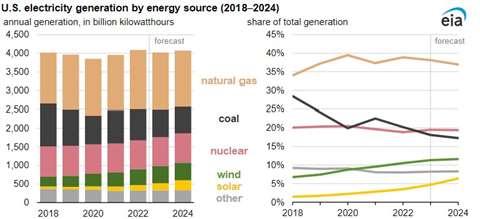EIA: Renewables will cut into coal, natural gas power production
19 January 2023
Most growth in Texas, California

U.S. power generation from new renewables capacity—mostly wind and solar—will reduce generation from both coal-fired and natural gas-fired power plants in 2023 and 2024, according to the U.S. Energy Information Administration (EIA).
The EIA’s latest Short-Term Energy Outlook forecasts that new solar and wind projects coming online in 2023 will account for 16% of total generation in 2023, up from 14% last year and 8% in 2018. The share of generation from coal falls from 20% in 2022 to 18% in 2023 and the forecast share from natural gas declines from 39% to 38%.
“One of the most significant shifts in the mix of U.S. electricity generation over the past few years has been the rapid expansion of renewable energy resources, especially solar and wind,” according to the EIA. The U.S. electric power sector operated about 74 GW of solar photovoltaic capacity at the end of 2022, which is about three times the capacity at the end of 2017. U.S. wind power has grown by more than 60% since 2017 to about 143 GW of capacity.”
Based on planned additions reported to EIA, solar capacity will expand another 63 GW (84%) by the end of 2024, which is consistent with its declining construction costs and favorable tax credits.
Still, solar power remains a relatively small slice of the overall power output: The EIA forecasts that the solar generation share will rise from 3% of U.S. generation to 5% in 2023 and 6% in 2024. Scheduled growth in wind power is slightly slower this year than in recent years, at about 12 GW of new planned capacity over the next two years. The forecast wind generation share in 2023 remains relatively similar to last year, averaging 11%, and then increases to 12% in 2024.
Much of the growth in solar capacity is in Texas and California, where natural gas has been the primary source of electricity, the EIA states.
“A growing share of generation from renewables, combined with our forecast of less overall electricity demand this year, displaces some natural gas generation, which will decline slightly, falling from 39% in 2022 to 38% this year and to 37% in 2024,” according to the EIA. “We also expect that the coal generation share will decline by two percentage points to 18% this year, as lower natural gas fuel costs make coal a less competitive source for electricity supply. Our forecast of coal generation falls again in 2024 to 17%.”
STAY CONNECTED




Receive the information you need when you need it through our world-leading magazines, newsletters and daily briefings.
POWER SOURCING GUIDE
The trusted reference and buyer’s guide for 83 years
The original “desktop search engine,” guiding nearly 10,000 users in more than 90 countries it is the primary reference for specifications and details on all the components that go into engine systems.
Visit Now
CONNECT WITH THE TEAM










